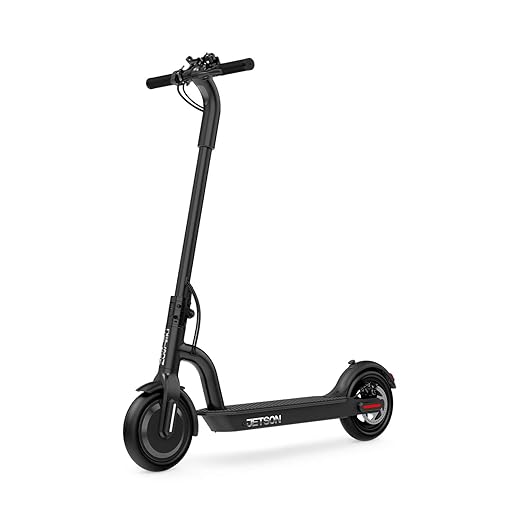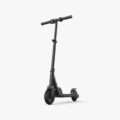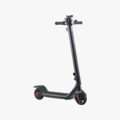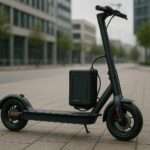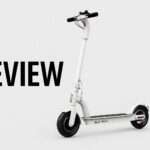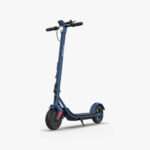- Home
- Scooters
- Electric Scooters
- Jetson Eris
Jetson Eris
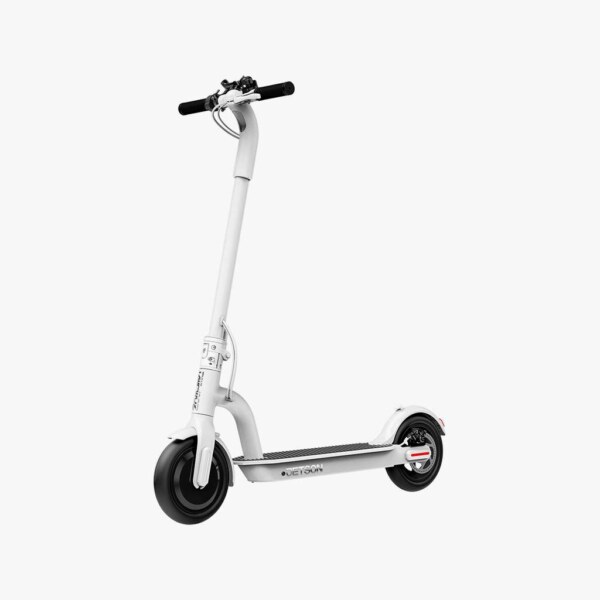

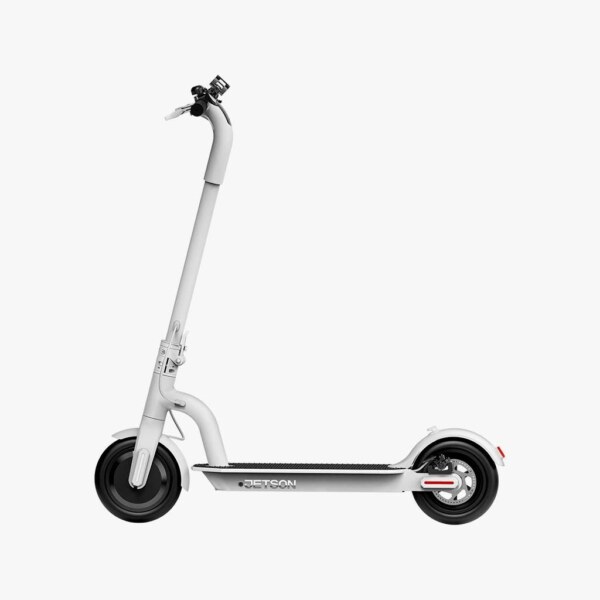
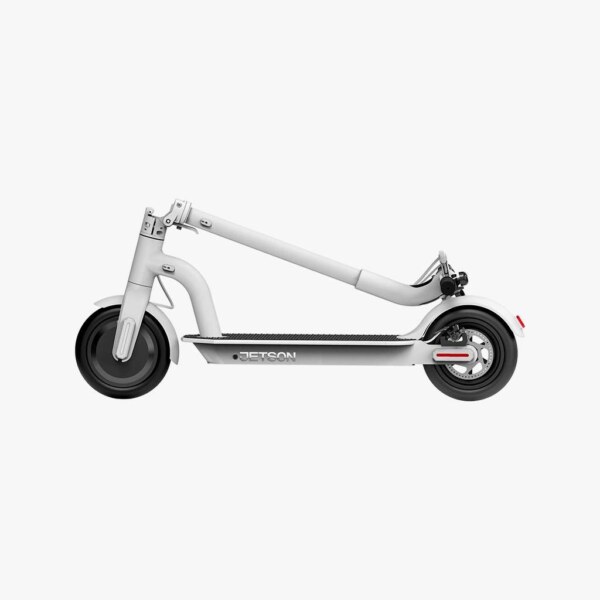
- Battery Range: 12 miles (19 km)
- Top Speed: 14 mph (22.5 km/h)
- Motor Power: 250 W
- Weight Capacity: 220 lb (100 kg)
- Charging Time: Approx. 5 hours
- Scooter Weight: 30 lb (13.6 kg)
PROS
- 14 mph (22.5 km/h) top speed suits short urban rides
- 12 miles (19 km) stated range for daily errands
- Relatively light 30 lb (13.6 kg) folding design
- Integrated LCD display and phone holder
- 8.5 in solid tires remove tube maintenance
CONS
- Solid tires reduce comfort on rough roads
- Short range versus many newer commuter scooters
- No suspension and single mechanical brake
- No Bluetooth app or advanced security features
Key Takeaways
- The Jetson Eris is a lightweight folding electric scooter designed for short urban commutes, featuring a 250W motor and a 36V battery.
- It offers a top speed of 14 mph and a range of up to 12 miles in ideal conditions, making it suitable for last-mile travel.
- The scooter’s compact design allows for easy storage in tight spaces, while its simple controls make it beginner-friendly.
- Safety features include front and rear lights, a rear handbrake, and a stable low deck for easier mounting and dismounting.
- The Jetson Eris is ideal for light riders needing a reliable, portable scooter for short trips, but it struggles with steep hills and heavy loads.
Table of contents
- What Is the Jetson Eris?
- How the Jetson Eris Works
- Key Specifications
- Design & Build Quality
- Performance Fundamentals
- Battery, Range & Efficiency
- Ride Quality & Comfort
- Braking & Safety Features
- Portability & Daily Usability
- Maintenance & Care
- Weather & Seasonal Considerations
- Jetson Eris vs Alternatives
- Who the Jetson Eris Is (and Isn’t) For
The Jetson Eris is a compact folding electric scooter made for short daily rides. It fits new and casual riders who want simple controls, low weight, and calm behavior. You get a clean design, modest power, and practical specs that match city life. So it feels like an easy everyday tool, not a stunt machine.
What Is the Jetson Eris?
The Jetson Eris is a lightweight commuter scooter with a 250W rear hub motor and a 36V lithium ion battery. Top speed reaches up to 14 mph (22.5 km/h). Claimed range goes up to 12 mi (19 km) in ideal flat conditions. Max rider weight stands at 220 lb (100 kg).
It aims at short trips. So think last mile from station to home, campus loops, quick grocery runs, and simple local rides. Not long tours. Not big hills all day.
The frame folds fast, the deck stays slim, and the controls are easy to read. You step on, press power, pick a mode, give a small push, then press the thumb throttle. That routine feels natural after one or two rides.
The scooter stays compact enough for indoor storage. So riders in apartments, dorm rooms, or offices can slide it under a desk or along a wall without turning the place into a parking lot.
How the Jetson Eris Works
Power comes from the 250W motor in the rear wheel. When you press the thumb throttle, the controller sends power from the 36V 7.5Ah battery to that motor. The pull feels smooth, not jumpy.
So it rides like a steady electric push under your feet. Your thumb sets how strong that push feels. The ramp up stays gentle, and that keeps the scooter from lunging forward. This calm behavior helps around people, crosswalks, and tight paths.
The LCD display sits in the center of the handlebar. You see speed, battery level, and mode in clear numbers. Buttons near the display control power and mode. So you get what you need in one quick glance.
Braking runs through a rear hand lever. Pull the lever and the scooter slows in a straight, predictable line. Some units add a bit of motor drag when you roll off the throttle, and that small effect trims speed before you brake harder.
Front and rear lights improve visibility in low light. A built in kickstand keeps the scooter upright when parked. So the whole setup leans toward simple, repeatable daily use.
Key Specifications
| Block | Details |
|---|---|
| General | Brand: Jetson. Model: Eris. Recommended age: 12+. Max rider weight: 220 lb (100 kg). Use: short city, campus, and last mile rides. |
| Performance & Power | Motor: 250W rear hub. Top speed: up to 14 mph (22.5 km/h). Claimed climbing: up to 20° with light riders and short hills. |
| Battery, Charging & Electrical | Battery: 36V 7.5Ah lithium ion (about 270 Wh). Claimed range: up to 12 mi (19 km) in ideal use. Charge time: up to 5 hours from low. Display: LCD with speed and battery. |
| Build & Dimensions | Frame: aluminum. Tires: 8.5 in solid. Deck length: about 21.88 in (55.6 cm). Deck width: about 5.70 in (14.5 cm). Unfolded: about 41.50 x 17.17 x 41.28 in (105.4 x 43.6 x 104.9 cm). Folded: about 41.50 x 17.17 x 19.00 in (105.4 x 43.6 x 48.3 cm). Weight: about 30 lb (13.6 kg). |
| Safety & Control | Rear handbrake. Low deck for stable stance. Front light and rear light. Basic reflective details by batch. Water resistant housing for day to day splashes. |
| Features & Extras | Foldable stem. Kickstand. LCD display. Simple ride modes. Some bundles include a phone holder. No Bluetooth. No listed cruise control. |
| Warranty & Compliance | Supplied with limited warranty on main parts. Riders must follow local rules on age, helmets, paths, and road use. |
These specifications place the Jetson Eris in the light entry level commuter group.
Design & Build Quality
The Jetson Eris looks neat and low key. The straight stem, slim deck, and simple lines fit office halls, dorms, and sidewalks without shouting for attention. That style suits riders who just want transport that blends in.
The aluminum frame keeps weight down and still feels steady for its speed and load. Joints and welds stay tucked in, and exposed cables are short and close to the frame. So the scooter does not look messy.
The folding hinge at the stem base is the main moving part. When you lock it right, it feels firm and keeps the bars lined up. A quick tug test before riding turns into a small habit and keeps steering tight.
The deck is long enough for a natural staggered stance. Width is slim, so your feet sit close but stable. Grip tape or textured rubber holds shoes in place when the surface is dry or a bit dusty.
Up top, controls are simple. Thumb throttle on one side, brake lever on the other, display in the center with power and mode buttons. New riders figure it out in a few minutes. Nothing fancy, which honestly helps.
Build quality fits its role. If you avoid big hits, store it inside, and keep bolts snug, it feels solid across regular short rides.
Performance Fundamentals
The Eris sits in the mild power range, and you feel that right away. From a stop on level ground it gets moving without rush. Then it works up to its 14 mph top speed in a smooth, steady pull.
On flat routes with a rider under 220 lb, it holds a comfortable cruise. Add rough pavement, strong wind, or long shallow climbs and speed drops a bit. So it makes more sense in flatter or mixed but gentle areas.
On hills around 7 to 10 percent, results vary. A lighter rider on a short hill gets to the top at slower speed. A heavier rider or a longer climb may help with a few kicks, or pick an easier side street. It does not pretend to be a hill crusher.
Steering feels light and quick. The wheelbase and bar width give enough stability for its speed range. If the hinge latch stays tight, straight line ride feels calm. Sharp steering moves on small solid tires can feel nervous, so smooth hands work better.
Treat the Jetson Eris as a calm city scooter. Then its performance lines up with what you expect.
Battery, Range & Efficiency
The 36V 7.5Ah pack gives about 270 Wh to work with. The claimed 12 mi (19 km) comes from flat ground, lighter riders, steady speed, and warm weather.
Real rides look different. A rider around 150 lb on smooth bike paths, with steady throttle, lands close. A rider near 220 lb with stops, hills, and rough streets lands lower. So a fair planning range for mixed use sits around 7 to 9 mi (11 to 14 km), with some buffer left.
Smooth habits help. If you hold a steady pace instead of snapping full throttle, you get more out of each charge, and the pack runs cooler.
Charging from low to full usually takes up to 5 hours. Many riders plug in after work or school. For long breaks, leave it around half charge in a cool, dry room, not empty in a hot hallway.
The battery and motor match its job. Short loops, errands, and last mile trips feel natural for this setup.
Ride Quality & Comfort
The Jetson Eris rolls on 8.5 inch solid tires and skips suspension. That means no flats from glass or nails and less hassle. It also means more of the road comes through the deck and bars.
On clean asphalt the ride feels firm and controlled. You feel contact, yet the scooter stays stable. On patched roads, rough concrete, or tiles, vibration jumps up. So bending knees and staying loose in your arms makes a clear difference.
Big potholes, sharp curbs, or broken edges are not friendly. The small solid tires do not swallow those hits. Pick smoother lines, slow over bumps, and avoid “sending it” into gaps.
Handlebar height works for most teens and average height adults. Very tall riders might want a bit more height on long rides, though they can live with it on shorter ones. Grips let you cover throttle and brake without stretch.
If the latch is tight, stem flex stays low. A small hint under heavy load can show up, and that is normal in this class.
For short to medium trips on decent paths, comfort is fine. For rough streets all day, a scooter with air tires or suspension fits better.
Braking & Safety Features
The rear handbrake does the main stopping work. Lever feel starts soft and builds up in a smooth curve. So you can feather speed or dig in for a firm stop.
From top speed on dry pavement, a strong, steady pull with weight centered slows the scooter in a straight line. New riders should test a few stops in a quiet area. Then the real world stuff feels less surprising.
Some units add mild motor slowing when you release the throttle. That little bit helps on gentle downhills and tight areas.
Built in front and rear lights cover basic visibility. They help you get seen at dawn, dusk, or shaded streets. Night riders often add brighter lights or reflective gear for extra safety, which makes sense.
The low deck height makes stepping off simple at low speed. It also helps stability in regular riding.
The scooter handles splashes and damp patches but does not like deep puddles or heavy soaking rain. Keeping clear of those saves the electronics and bearings.
Rules change from place to place. So match your speed, route, and helmet use to local laws.
Portability & Daily Usability
Portability is one of the Jetson Eris strong sides. At about 30 lb, it feels carryable for many riders, even if not super fun on long stairs.
The stem hinge lets you fold it in a short sequence. Flip, fold, secure. Then it fits under desks, next to chairs, into car trunks, or in tight hallway corners. It does not take over your living space.
For mixed trips with bus or train, you can roll it beside you by the stem. Short carries up steps or through stations are manageable. So it works well as a real commuter tool, not just a weekend ride.
Good locking habits matter. Indoor storage cuts risk of theft and weather damage. If you park outside, lock through the frame or deck to something solid and keep the stop short.
Start up stays quick. Power on, glance at the battery, pick a mode, small push, throttle. That speed makes it easy to choose the scooter for quick errands where a car feels like overkill.
Maintenance & Care
The Jetson Eris keeps things friendly if you are not a heavy DIY person.
Before each ride:
Check the stem latch and handlebar clamp for any play.
Pull the brake lever to confirm firm feel.
Switch on lights to make sure they work.
Look at the solid tires for cracks or chunks missing.
Each week if you ride a lot:
Check bolts at the hinge, bars, and brake mount. Tighten lightly if anything moves.
Wipe dust from the deck, stem, display, and charge port cover.
Listen during a short spin for new rattles or rubbing sounds.
Each month:
Inspect rear brake parts for wear or misalignment.
Check deck grip for peeling or smooth glossy spots.
Fold and unfold the stem to confirm smooth action and solid lock.
Every few months:
Look over cables for pinch marks or cuts.
Check the charger plug and charging port for dirt or rust.
Watch for clear range drops across several rides, not just one bad day.
Clean it with a damp cloth, not a jet of water. Store it inside, dry, away from heat sources. If it ever feels wobbly, weak on brakes, or noisy in a bad way, pause riding until you sort that out.
Weather & Seasonal Considerations
Real life means mixed weather, so the Eris has to handle a bit of everything.
On light rain and damp streets, it can still roll. Grip on solid tires drops faster though. So ride slower, give yourself more room to stop, and keep the scooter more upright. Painted lines, metal covers, and smooth tiles get slippery fast.
Cold days cut range. Near freezing, expect fewer miles. Keeping the scooter indoors before your ride helps, then charge again at room temperature later.
Hot days load extra stress on the battery. Do not leave it locked in a closed car in direct sun for long blocks of time. Let it cool to a normal level before charging.
Snow, ice, and heavy slush are not its thing. Traction falls, water gets everywhere, and the ride stops being fun. On those days, walking or picking another option works better.
With a bit of care, the Jetson Eris manages most seasons fine.
Jetson Eris vs Alternatives
Riders usually stack the Jetson Eris against three types of scooters.
First, bigger commuter scooters with stronger motors and larger batteries. Those bring more speed and range, plus better hill help. The Eris hits back with less weight, easier carrying, and easier storage. So if your rides are short and your space is small, this trade makes sense.
Next, off road or dual motor scooters. Different story. Those are heavy, powerful, and built for rough paths. The Eris is not chasing that. It sticks to paved routes, bike lanes, and everyday city lines.
Then, tiny ultra compact scooters with very small wheels. The Eris feels more like a real daily scooter than those. You get a longer deck, more stable stance, and a cockpit that feels less toy like, while it still folds and fits in tight spots.
If you ever look at upgrades inside the same family, you might glance at the Jetson Eris Pro as a stronger step for later, once you outgrow the base model.
So the Jetson Eris lands as a middle ground for light riders who want real standing room, true portability, and clear expectations.
Who the Jetson Eris Is (and Isn’t) For
The Jetson Eris works best for riders with simple daily needs.
Good match:
Short commutes up to about 4 to 5 mi (6.5 to 8 km) each way.
Students rolling between classes, dorms, and transit.
City and suburban riders who link bus or train with a last mile scooter.
New riders who want gentle power and clear controls.
Homes that share one light scooter between teens and adults.
Weak match:
Riders close to or above 220 lb (100 kg).
Daily routes built on long, steep hills.
People chasing long high speed runs or heavy cargo.
Regular off road or broken road riding.
Riders who expect a very soft, floating feel.
If you need something tiny and friendlier for younger kids instead, a model like the Hover-1 My First E-Scooter fits that role better than the Eris.
For the right rider, the Jetson Eris feels easy going. You grab it, ride your loop, fold it, bring it inside, done. Stay within its limits on range, power, and terrain, and it slots into daily life in a simple and reliable way.
Specifications
General
| Model The Model specifies the exact version or name of the scooter. It helps identify its unique design, features, and specifications within the manufacturer’s product line. Knowing the model makes it easier to compare options, find compatible accessories, or look up support information. | Eris |
| Brand The Brand identifies the manufacturer or company that designs and produces the scooter. A trusted brand is a sign of quality, reliability, and good customer support. Well-known brands often have higher standards for safety, performance, and after-sales service, giving you more confidence in your purchase. | Jetson |
| Release Date The Release Date indicates when the scooter model was officially launched on the market. This helps you know how current the design, technology, and features are. A newer release date often means updated components, improved performance, and the latest safety or smart features. | 18 November 2025 |
| Recommended Age Recommended Age indicates the minimum age range that the scooter is designed for, based on safety, size, and ease of use. Following the recommended age helps ensure that riders can handle the scooter’s speed, weight, and controls comfortably and safely. Always check local laws and use protective gear, especially for younger riders. | 12+ |
Performance & Power
| Motor Power (Wattage) What it means: The motor power, measured in watts (W), shows how strong the scooter’s electric motor is. Why it matters: Higher wattage usually means better acceleration, more torque, and improved performance on hills or rough terrain. For example, a 250W motor is good for flat city roads and light riders, while a 500W or 1000W motor provides more power for faster speeds or climbing steep inclines. | 250 W hub motor |
| Top Speed The Top Speed indicates the maximum speed that the scooter can reach under optimal conditions. It’s usually measured on level ground with a fully charged battery and an average rider weight. A higher top speed allows you to travel longer distances faster, but always ensure you ride within legal speed limits and your personal comfort zone for safety. | 14 mph (22.5 km/h) |
| Battery Capacity Battery Capacity refers to the total amount of energy the scooter’s battery can store, usually measured in ampere-hours (Ah) or watt-hours (Wh). A higher battery capacity means you can ride longer distances on a single charge, reducing the need for frequent recharging. Keep in mind that actual range can vary depending on rider weight, terrain, speed, and weather conditions. | 36 V 7.5 Ah (270 Wh) |
| Estimated Range per Charge The Estimated Range per Charge indicates the average distance the scooter can travel on a single full battery charge. This range is calculated under optimal conditions, such as flat terrain, moderate speed, and average rider weight. Real-world range may vary depending on riding style, terrain, weather, and load. A longer range means fewer recharges and greater freedom for longer trips. | 12 miles (19 km) |
| Hill Climb Ability Hill Climb Ability describes the maximum incline or slope that the scooter can handle while maintaining stable performance. It’s typically expressed as a percentage or in degrees. A higher hill climb rating means the scooter can tackle steeper hills without losing too much speed or power. Actual climbing performance may vary based on rider weight, battery charge, and terrain conditions. | 20° (~36% grade) |
| Drive System The Drive System refers to how power from the motor is delivered to the wheels. Electric scooters typically use either a hub motor (directly integrated into the wheel) or a chain/belt drive system. A high-quality drive system ensures smooth acceleration, efficient power transfer, and low maintenance. The choice of drive system affects performance, noise level, and overall ride experience. | Rear hub (RWD) |
Charging & Electrical
| Charging Time Charging Time indicates how long it takes to fully recharge the scooter’s battery from empty to 100% using the standard charger provided. Faster charging means less downtime and more time on the road. Actual charging time may vary slightly depending on battery capacity, charger output, and environmental conditions. | Approx. 5 hours |
| Battery Type Battery Type refers to the specific technology used in the scooter’s battery, which affects performance, lifespan, weight, and charging time. Most modern electric scooters use high-quality lithium-ion (Li-ion) batteries because they offer a good balance of energy density, durability, and low maintenance. A reliable battery type ensures consistent power delivery and longer riding ranges. | 36 V 7.5 Ah lithium-ion battery with BMS |
| Removable Battery A Removable Battery means the battery pack can be easily detached from the scooter for convenient charging and replacement. This feature allows you to charge the battery separately, swap it with a spare for extended range, or securely store it indoors in extreme weather. Removable batteries add flexibility and make it easier to keep your scooter powered up wherever you are. | Non-removable internal battery |
| Regenerative Braking Regenerative Braking is an energy-saving feature that converts some of the energy normally lost during braking back into battery power. When you slow down or brake, the motor works in reverse to generate electricity, which helps extend the scooter’s range and improves overall efficiency. This system also reduces wear on traditional brake components, leading to lower maintenance over time. | Not specified |
| Lighting Lighting refers to the built-in front and rear lights that enhance visibility and safety when riding in low-light conditions or at night. Good lighting helps you see the road ahead and ensures that other road users can see you. Many scooters include LED headlights, taillights, and sometimes brake lights or side reflectors for added safety and compliance with local traffic regulations. | LED headlight and rear light |
Build & Dimensions
| Scooter Weight Scooter Weight refers to the total weight of the scooter when fully assembled, including the battery. This affects how easy it is to carry, lift, and store the scooter when not in use. A lighter scooter is more portable and convenient for commuting, especially if you need to carry it upstairs or onto public transport. Keep in mind that a sturdy frame and quality components may add to the weight but also contribute to better durability and ride stability. | 30 lb (13.6 kg) |
| Maximum Rider Weight Maximum Rider Weight indicates the highest rider weight that the scooter is designed to safely support while maintaining optimal performance and stability. Staying within this limit helps ensure reliable acceleration, braking, and climbing ability, and it protects the frame, suspension, and motor from excessive strain. Exceeding the recommended limit may reduce performance and increase wear on components. | 220 lb (100 kg) |
| Deck Size Deck Size refers to the dimensions of the scooter’s standing platform. A wider and longer deck provides more foot space, allowing you to stand comfortably and adjust your stance while riding. A well-sized deck improves balance and stability, especially on longer rides or at higher speeds. Compact decks, on the other hand, help keep the scooter lightweight and portable. | Foldable commuter frame with low deck |
| Handlebar Height Handlebar Height refers to the distance from the deck to the handlebars, which affects your riding posture and comfort. An appropriate handlebar height helps you maintain good balance, reduces strain on your back and arms, and makes steering more comfortable. Some scooters have adjustable handlebars to fit riders of different heights, while others have a fixed height for a streamlined design. | Fixed height approx. 41.3 in (105 cm) |
| Folding Mechanism The Folding Mechanism describes how easily and securely the scooter can be folded for carrying and storage. A well-designed folding system lets you quickly collapse the scooter into a compact size, making it convenient to transport on public transit, store under a desk, or fit into a car trunk. Look for sturdy latches and safety locks to ensure the scooter stays firmly in place when folded or unfolded. | Single-step folding stem with latch |
| Dimensions Folded Dimensions indicate the size of the scooter when it’s fully folded. This measurement shows how much space the scooter will take up when stored or carried, making it easier to check if it will fit in your car trunk, under a desk, or in a closet. Compact folded dimensions are ideal for commuters who need to bring their scooter on public transport or store it in tight spaces. | Unfolded: 41.5 x 17.2 x 41.3 in (105.4 x 43.7 x 104.9 cm); Folded: 41.5 x 17.2 x 19.0 in (105.4 x 43.7 x 48.3 cm) |
| Material Material refers to the primary construction materials used for the scooter’s frame and key components. High-quality materials like aircraft-grade aluminum, reinforced steel, or durable composites provide strength, stability, and a lighter overall weight. A sturdy material ensures the scooter can handle daily wear and tear while maintaining safety and performance. | Aluminum alloy |
Safety & Control
| Brake Type(s) Brake Type(s) describe the braking systems the scooter uses to help you slow down or stop safely. Common brake types include mechanical brakes (like drum or disc brakes), electronic brakes, and foot brakes. Many scooters combine multiple braking systems for added safety and shorter stopping distances. The type and quality of brakes affect your control, especially when riding at higher speeds or on slopes. | Rear hand-operated brake (mechanical) |
| Suspension Suspension refers to the system that absorbs shocks and vibrations while riding, providing a smoother and more comfortable ride over uneven or rough surfaces. Scooters may have front suspension, rear suspension, or dual suspension for better shock absorption and stability. Good suspension helps reduce rider fatigue and improves control, especially when riding on bumpy roads or off-road paths. | None |
| Tire Type Tire Type refers to the kind of tires the scooter uses, which directly affects ride comfort, traction, and maintenance. Common types include solid (airless) tires, pneumatic (air-filled) tires, or hybrid options. Pneumatic tires offer better shock absorption and a smoother ride on rough surfaces, while solid tires are puncture-proof and require less upkeep. The right tire type helps ensure safe handling and a comfortable ride in different conditions. | 8.5 in solid rubber tires |
| Tire Size Tire Size indicates the diameter and width of the scooter’s tires, which affect ride comfort, stability, and how well the scooter handles different terrains. Larger tires generally offer better shock absorption and a smoother ride over bumps and rough surfaces, while smaller tires keep the scooter lighter and more portable. Choosing the right tire size helps ensure a balance between agility and comfort. | 8.5 in |
| Kickstand The Kickstand is a built-in stand that allows you to park your scooter upright when it’s not in use. A sturdy kickstand keeps the scooter stable and prevents it from tipping over, protecting it from scratches and damage. It also makes storing and accessing your scooter more convenient, whether you’re at home, work, or on the go. | Side kickstand |
| Water Resistance Rating Water Resistance Rating indicates how well the scooter is protected against water and moisture, usually shown as an IP (Ingress Protection) rating. This rating helps you understand whether the scooter can handle light rain, splashes, or wet roads without damage. While most scooters are not fully waterproof, a good water resistance rating adds peace of mind when riding in changing weather conditions. Always avoid deep puddles or submerging the scooter to protect its electrical components. | Not specified |
Features & Extras
| Display/Console The Display (or Console) shows important real-time information about your ride, helping you monitor your scooter’s status at a glance. Typical displays show speed, battery level, distance traveled, and riding mode. Some models also include additional features like Bluetooth connectivity, app integration, or backlighting for better visibility at night. A clear and easy-to-read display enhances safety and convenience on every trip. | LCD display with speed and battery readout |
| Ride Modes Ride Modes refer to the different speed and power settings you can choose to match your riding style or road conditions. Common modes include eco for maximum range and energy efficiency, standard for everyday balance, and sport or turbo for higher speed and stronger acceleration. Switching between ride modes allows you to customize performance, conserve battery, and ride safely in various environments. | Not specified |
| Smart App Connectivity Smart App Connectivity lets you pair your scooter with a dedicated mobile app via Bluetooth. Using the app, you can monitor real-time ride stats like speed, battery level, and range, adjust settings such as ride modes or cruise control, lock the scooter for added security, and sometimes receive firmware updates. This feature adds convenience and allows you to personalize your riding experience right from your smartphone. | No dedicated app |
| Anti-Theft System The Anti-Theft System helps protect your scooter from unauthorized use or theft. This feature can include built-in alarms, electronic motor locks, GPS tracking, or remote locking through a mobile app. A good anti-theft system provides peace of mind when parking your scooter in public spaces, adding an extra layer of security to safeguard your investment. | Bell and rear light; no electronic lock |
| Cruise Control Cruise Control allows you to maintain a steady speed without continuously holding the throttle. This feature makes longer rides more comfortable by reducing hand fatigue and providing a smoother, more relaxed riding experience — especially on flat, open roads or bike lanes. For safety, cruise control can usually be easily activated or deactivated while riding. | Not specified |
| Accessories Included Accessories Included lists the additional items that come with the scooter to enhance your riding experience and convenience. Common accessories may include a charger, kickstand, bell, lights, phone holder, or carrying strap. These extras add value by making your scooter safer, easier to use, and ready to ride straight out of the box. | Eris scooter, charger, user manual |
Warranty & Compliance
| Warranty Period The Warranty Period indicates how long the manufacturer guarantees the scooter against defects in materials and workmanship under normal use. A good warranty provides peace of mind, showing the brand’s confidence in its product quality. Always check what parts are covered, such as the frame, battery, and motor, and follow the maintenance guidelines to keep your warranty valid. | 180 days limited warranty |
| Certifications Certifications confirm that the scooter meets specific safety, quality, and environmental standards set by recognized organizations or regulatory bodies. Common certifications may include CE, RoHS, UL, or other local compliance marks, depending on your region. These certifications ensure that the scooter is manufactured to high standards and is safe and legal to use in your country. | Region-dependent; follow local micromobility regulations |



